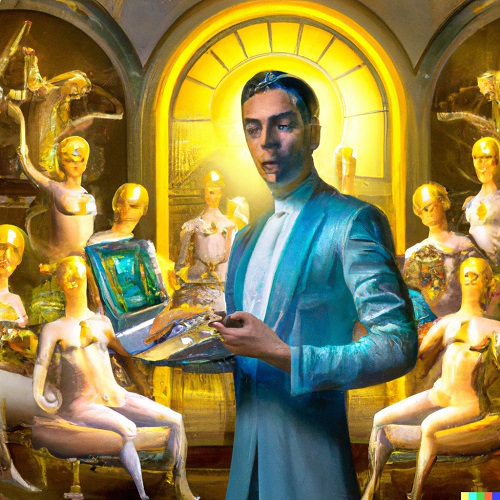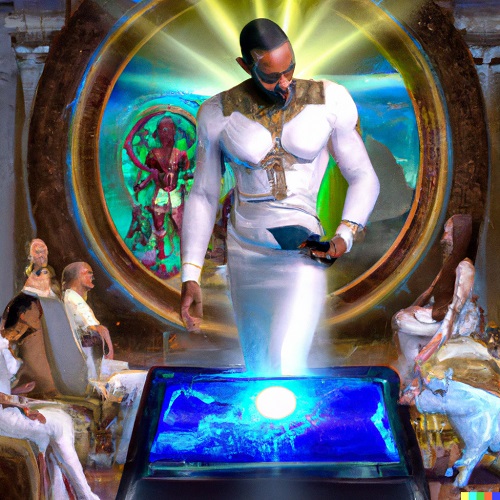
Artificial Intelligence (AI) is rapidly transforming the art world in ways that were previously unimaginable. From generating entirely new artworks to enhancing and assisting artists in their creative process, AI has the potential to create new forms of art that were not previously possible. While there are some concerns about the role of AI in art, it is clear that AI has the potential to create new and exciting forms of art that we have yet to explore.
This article aims to provide a balanced overview of how AI is impacting the art world while also discussing some of the criticisms and concerns around its use. Additionally, it will offer concrete recommendations and ideas for artists who want to use AI in their creative process.
Generating Art with AI Models
AI models are capable of generating entirely new artworks, including images, music, and text. These generated artworks often exhibit a unique perspective on the creative process and can be strikingly beautiful. AI models use a variety of techniques to generate art, including generative adversarial networks (GANs), variational autoencoders, and neural style transfer.
One example of AI-generated artwork is the “Portrait of Edmond de Belamy,” created by the Paris-based art collective Obvious. This artwork was created using a GAN, a type of AI model that can generate highly realistic images. The GAN was trained on a dataset of 15,000 portraits from the 14th to the 20th centuries and used this training data to generate a new portrait. The portrait was then printed on canvas and sold at auction for over $430,000.
Another example of AI-generated art is the “Infinite Skulls” project by artist Robbie Barrat. The project used a GAN to generate new images inspired by the work of famous artists such as Rembrandt and Salvador Dali. The resulting images were surreal and dreamlike, showing the unique perspective that AI can bring to the creative process.
Enhancing Art with AI Models
AI models can also be used to enhance existing works of art. This technique involves analyzing the original artwork and generating a new version that emphasizes different aspects of the original. AI can be used to enhance details that may have been lost over time, create new versions of classic artworks, and even generate entirely new perspectives on existing works.
One example of AI being used to enhance art is the work of artist Mario Klingemann. Klingemann uses AI models to create new versions of classic artworks, emphasizing different aspects of the original. For example, an AI model might create a version of the Mona Lisa with brighter colors, or one that emphasizes the texture of the paint.
The “DeepDream” project by Google already from 2015, which uses neural networks to find and enhance patterns in images, was originally created to assist with image recognition. However, researchers quickly realized that the system could be used to generate visually stunning and surreal images that are unlike anything a human artist might create. By tweaking the parameters of the neural network, the system can create images that range from dreamlike and abstract to hyper-realistic and detailed. The DeepDream project has since been used in a variety of creative applications, including music videos and album covers.
Assisting Artists with AI Models
AI models can also be used to assist artists in their creative process. This technique involves using AI to generate ideas, provide technical assistance, and even create new artworks based on the artist’s input.
One example of AI assisting artists is the “Drawing Operations” project by artist Sougwen Chung. Chung uses an AI model to create her artworks, with the model analyzing the artist’s movements and generating images based on those movements. The model is used as a tool for exploration and experimentation, allowing the artist to create new and unique artworks.
Another example is the “The Next Rembrandt” project by advertising agency J. Walter Thompson Amsterdam. The project used AI to create a new Rembrandt painting, analyzing the artist’s style and creating a new painting based on that analysis. While the resulting painting was not created by Rembrandt himself, it showed how AI could be used to create new artworks based on the style of existing artists. This type of AI-assisted art creation can also provide new tools and ideas to artists who are exploring new directions in their work.
Collaborative Art with Humans

One of the most exciting applications of AI in art is the possibility of creating collaborative artworks with humans. The “Melting Memories” project by artist Refik Anadol is a notable example of how AI can create interactive and personalized art. The project uses EEG data from the brain of a human participant to generate images, creating a collaborative artwork that is unique to the participant’s brain activity.
Another example of collaborative art is the “ArtBreeder” project, which allows users to interact with AI models to create and evolve images collaboratively. Users can start with a basic image, then evolve it through a series of mutations, selecting the most interesting iterations along the way. The result is a collaborative creation that combines the human user’s input with the AI model’s ability to generate novel and unexpected images.
Art Accessibility
Another area where AI models can have a significant impact is in making art more accessible to people with disabilities. The “Artificial Vision for the Blind” research is an excellent example of how AI can be used to generate 3D-printed sculptures based on images of classic artworks. These sculptures can be touched and explored, providing a new way for people with visual impairments to experience art.
Another example of AI making art more accessible is the “Seeing AI” app, which uses AI to identify and describe visual art for people with visual impairments. The app can describe the colors, composition, and content of artworks, allowing people with visual impairments to appreciate art in a new and meaningful way.
Challenges and Limitations
While AI models have brought many benefits to the art world, they also face several challenges and limitations. One of the primary concerns is the potential loss of human creativity and emotions in the creation of AI-generated art. Critics argue that AI-generated art lacks the context, emotion, and social commentary that are essential elements of human-created art.
Another challenge is the issue of authenticity and value. AI-generated art often raises questions about ownership, authorship, and originality, and its value is a matter of debate in the art world. Some argue that AI-generated art is a novelty item with limited artistic merit, while others believe that it represents a new and exciting medium for artistic expression.
Lastly, not all artists have the technical skills or resources to use AI tools, and the cost of AI models and tools may be prohibitive for some artists, especially those who are just starting their careers.
Recommendations for Artists
Despite these challenges, AI has the potential to provide exciting new opportunities for artists. For those who are interested in exploring the use of AI in their creative process, there are a variety of tools and resources available.
One such resource is the open-source machine learning library TensorFlow, which can be used to train and develop AI models. There are also a variety of online courses and tutorials available that can help artists learn the technical skills needed to work with AI models.
In addition, there are a variety of platforms available for artists who want to collaborate with AI models or showcase their AI-generated art. Platforms such as Artbreeder and AI Art House provide tools and resources for artists who want to explore the creative potential of AI.
Conclusion
In conclusion, AI is transforming the art world in many ways, from generating entirely new artworks to making art more accessible to people with disabilities. While there are some concerns and limitations around the use of AI in art, there is also great potential for artists who are interested in exploring this new medium. As AI continues to evolve and improve, it is likely that we will see even more exciting applications of AI in the art world. It is essential to explore and address the concerns around the use of AI in art, while also recognizing the benefits and opportunities it presents for artistic expression and accessibility.
Ultimately, the use of AI in art is a new and rapidly evolving field, and it will be fascinating to see how artists continue to use this technology to push the boundaries of creativity and explore new possibilities. As AI tools and techniques continue to evolve and become more accessible, we can expect to see more artists using AI in their work and more innovative applications of AI in the art world. By embracing this new technology and pushing the limits of what is possible, artists can continue to evolve and create new forms of art that challenge and inspire us.